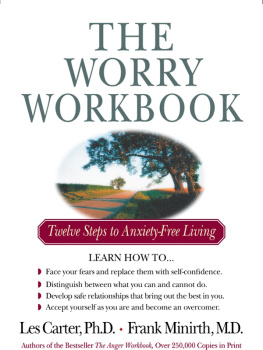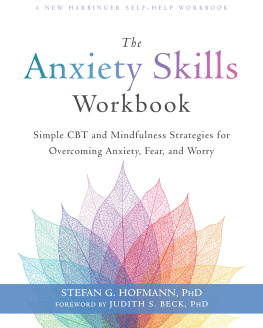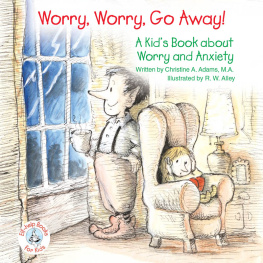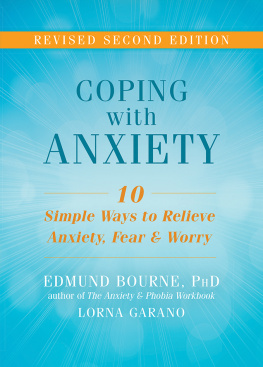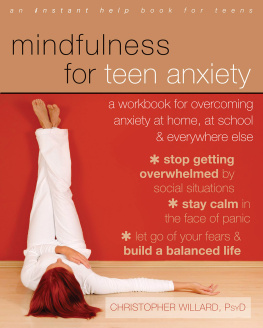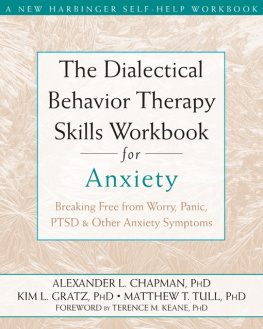
The Worry
Workbook
The Worry
Workbook
Twelve Steps to
Anxiety-Free Living
Les Carter, Ph.D.
and
Frank Minirth, M.D.

Copyright 2000 by Dr. Frank Minirth and Dr. Les Carter
All rights reserved. Written permission must be secured from the publisher to use or reproduce any part of this book, except for brief quotations in critical reviews or articles.
Published in Nashville, Tennessee, by Thomas Nelson, Inc.
Examples cited in this book are composites of the authors actual cases in their work at The Minirth Clinic. Names and facts have been changed and rearranged to maintain confidentiality.
ISBN 0-8407-7748-5
Printed in the United States of America
1 2 3 4 5 6 HART 05 04 03 02 01
Contents
Twelve Steps to
Anxiety-Free Living
1. Admit that anxiety can be known and managed.
2. Recognize that because of the presence of choices, fear does not have to result in emotional paralysis.
3. Learn to distinguish what you can and cannot control, then live accordingly.
4. Recognize that you alone are ultimately responsible for defining your own guidelines for life.
5. Communicate your anger constructively rather than holding it inward to fester.
6. Drop idealistic wishes that hinder you from accepting reality.
7. Realize that your self-directed thoughts of insecurity are the result of wrong input, and that those thoughts can be corrected.
8. Learn to distinguish safe from unsafe people and choose only healthy patterns of relating.
9. Drop the requirement of keeping up a proper front, and let the real you be known.
10. Release yourself from stringent performance requirements, accepting yourself as you are.
11. Realize that you can experience self-inflicted anxiety because of poor priorities, then choose priorities that will serve you best.
12. Know that each problem has some sort of resolution, and commit yourself to being an overcomer.
Many thanks are due once again to Marti Miller for the tremendous help she has given in preparation of the manuscript. Vickie Gage has also been invaluable in her efforts to keep us on target during this project. Once more we have found Janet Thoma and the staff at Thomas Nelson Publishers to be consummate pros in their work in editing and preparing the manuscript. Special thanks belong to Leslie Peterson, copy editor; Anne Trudel, managing editor; Kyle Olund, book design manager; Walter Petrie, interior designer; and the team of proofreaders who assisted in the production of this book.
Anxiety and its accompanying worry is one of the most common emotional ailments experienced by the people who visit our offices. Think about your own experiences with this emotion. What tends to worry you? What creates stress in your life? Your marriage? The kids? Finances? A packed schedule? A contentious coworker?
None of us is immune from the circumstances that feed worry and anxiety. You may be fortunate enough to experience some moments here and there that provide a respite from worry, but those moments never last forever, do they!
Our question to you is this: Do you understand why you can become caught in the trap of anxiety, and do you have a well-devised scheme that will see you through it successfully? Most people dont have a plan that directs them through their anxiety and worry, and that is what has prompted us to write this book.
The Worry Workbook is the fourth in our workbook series, and we have been very encouraged by the response thus far. (The others are The Anger Workbook, The Freedom fromDepression Workbook, and The Choosing to Forgive Workbook. ) As in the other workbooks, we have attempted to break down the problem of anxiety into components that you can readily identify. The more familiar you are with anxietys ingredients, the more capable you will be in applying the adjustments we identify. Our readers have communicated to us that they have benefited most from the challenge to be honest about their tendencies and by the guidance which stimulates them to apply their insights to specific circumstances.
The Worry Workbook can be used in more than one fashion. First, you may choose to study its contents and respond to its queries on an individual basis. We have tried to emphasize insights similar to the ones we discuss in our individual sessions with clients. Second, you may choose to have a partner who will work with you in responding to the information in each chapter. We are familiar with many married couples, families, or friendships that have benefited greatly by taking this team approach. Finally, you may decide to use the workbook as part of a group or classroom exercise where insights and interpretations can be shared in a wider fashion.
However you decide to use the information in the following pages, know that we wish you well. The workbook format is not a substitute for professional counseling, but it certainly can give you an idea of the things that might be explored in a counseling office. As you read, you will notice how we refer to case examples to show how our discussions might unfold in real settings. Please understand that each case example presented in the book is a compilation of cases we have encountered, and great care has been taken to protect individual privacy.
1
The Many Forms
of Anxiety
Step 1. Admit that anxiety can
be known and managed.
Brenda was enjoying a leisurely Saturday morning, sipping her second cup of coffee, when her homes silence was broken by the telephone. Her sister, Teresa, was on the line and clearly she was upset. Youve got to help me, Teresa said frantically. If one more thing goes out of whack in my life, I think Ill just fall apart. I cant take too much more.
Slow down, Little Sis. Whatever is bothering you, it cant be that bad. Brenda knew that her sister tended to inflate her problems, making every stress factor larger than necessary. So in her most soothing voice she inquired, Is something wrong again with that boyfriend of yours? Did he stand you up again? Has he been mistreating you?
Well, things arent going that well with him, but thats not why I called. Teresa was a single mom trying her best to raise her only daughter, Britanny, in a stable environment. Almost sixteen, Britanny was a delight most of the time; nonetheless, she had moments when she challenged her mom, creating aggravation.
Teresa continued, Britanny and I had an awful argument. She went out with some of her girlfriends last night, and some boys came over to her friends house while the parents were gone. These boys are the same ones Ive chased away from our place, and Britanny knows I dont approve of her being with them.
For the next several minutes Teresa bent her sisters ear about her less than successful efforts at getting her daughter to promise never again to see those boys. Brenda was a patient listener and gave the best advice she could, keeping her composure as she played counselor.
Once she hung up the phone, Brenda broke down in tears. She couldnt let Teresa know that she, too, was stressed out. Her worries about her sister and niece ran deep, and she frequently agonized about what to say or do to help. For the rest of the weekend she couldnt get the conversation off her mind.
The following Tuesday she had an appointment with Dr. Carter. Im a nervous wreck every time I get off the phone with anyone in my family, particularly my sister, Teresa. Were very close and she looks to me as a sounding board for her problems, but frequently I dont know what to do. It seems that every couple of weeks or so she comes up with a new crisis. I try to be a calming influence on her because, heaven knows, she doesnt need any more problems from me, but she has no idea how she can emotionally wear me out!
Next page
